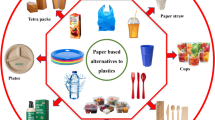Abstract
In this paper, fuzzy logic method was used to model the effect of stain repellent treatment on plush knitted fabrics intended for baby clothes. In order to reduce the complexity of the models and increase the knowledge and comprehension of the underlying process, a fuzzy sensitivity variation criterion was used to select the most relevant parameters which are taken as inputs of the reduced fuzzy logic models. The outputs are the water-oil contact angles characterizing the stain repellent behavior of fabrics and the percentage of decrease of air permeability to control the change of hygienic comfort. Obtained results showed that the hydrophilic samples were transformed to water-oil repellent ones and some experimental conditions induce a high contact angle without affecting the air permeability.
Similar content being viewed by others
References
S. Kathirvelu, L. D’Souza, and B. Dhurai, J. Tex. Inst., 101, 520 (2010).
I. Holme, Color Technol., 123, 59 (2007).
J. P. Badyal, Chem. Br., 37, 45 (2001).
H. Bubert, “Surface and Thin Film Analysis”, Ullmann’s Encycl, Ind. Chem., doi:10.1002/14356007.b06_023.pub2, 2011.
M. L. Ma, M. Gupta, L. Zhai, K. K. Gleason, R. E. Cohen, M. F. Rubner, and G. C. Rutledge, Adv. Mater., 19, 255 (2007).
J. Maity, C. Jacob, C. K. Das, and R. P. Singh, J. Appl. Polym. Sci., 107, 3739 (2008).
S. Tarimala, N. Kothari, N. Abidi, E. Hequet, J. Fralick, and L. L. Dai, J. Appl. Polym. Sci., 101, 2938 (2006).
J. T. Yeh, C. L. Chen, and K. S. Huang, J. Appl. Polym. Sci., 103, 3019 (2007).
T. Wang, X. Hu, and S. Dong, Chem. Commun., 18, 1849 (2007).
C. H. Xue, S. T. Jia, H. Z. Chen, and M. Wang, Sci. Technol. Adv. Mater., 9, 035001 (2008).
H. Wang, J. Fang, T. Cheng, J. Ding, L. Qu, L. Dai, X. Wang, and T. Lin, Chem. Commun., 7, 877 (2008).
B. Leng, Z. Z. Shao, G. de With, and W. Ming, Langmuir, 25, 2456 (2009).
Y. Zhao, Y. W. Tang, X. G. Wang, and T. Lin, Appl. Surf. Sci., 256, 6736 (2010).
A. Borisova and S. Reihmane, Mater. Sci., 19, 169 (2013).
G. Y. Bae, B. G. Min, Y. G. Jeong, S. C. Lee, J. H. Jang, and G. H. Koo, J. Colloid Interface Sci., 337, 170 (2009).
L. A. Zadeh, Information and Control, 8, 338 (1965).
H. J. Zimmerman, “Fuzzy Set Theory and Its Applications”, 2nd ed., pp.109–169, Allied Publishers Limited, New Delhi, 1996.
R. C. Berkan and S. L. Trubatch, “Fuzzy Systems Design Principles”, pp.22–131, Standard Publishers Distributors, New Delhi, 2000.
S. V. Kartalopoulos, “Understanding Neural Networks and Fuzzy Logic: Basic Concepts and Applications”, pp.75–82, Prentice-Hall of India Pvt. Ltd., New Delhi, 2000.
G. J. Klir and B. Yuan, “Fuzzy Sets and Fuzzy logic: Theory and Applications”, pp.35–49, Prentice-Hall of India Pvt. Ltd., New Delhi, 2000.
C. R. Bector and S. Chandra, “Fuzzy Mathematical Programming and Fuzzy Matrix Games”, pp.21–56, Springer, Berlin, 2004.
C. Altinoz and S. Winchester, J. Text. Inst., 92, 155 (2001).
B. Jaouachi, M. B. Hassen, M. Sahnoun, and F. Sakli, J. Tex. Inst., 101, 111 (2010).
T. Hyung, H. Sung, R. Sook, Y. Jae, and H. Seong, Text. Res. J., 71, 563 (2001).
G. Castellano and A. M. Fanelli, Neurocomputing, 31, 1 (2000).
N. Kwak and C. H. Choi, IEEE Trans. Neur. Net., 13, 143 (2002).
F. Fleuret, J. Mach. Learn. Res., 5, 1531 (2004).
X. Deng, P. Vroman, X. Zeng, and L. Koehl, “A Fuzzy Logic Based Criterion for Selecting Relevant Process Parameters for Design of Nonwoven Products”, Vol. 1, pp.205–210, IMACS Multiconferences on Computational Engineering in Systems Applications, Beijing, 2006.
X. Deng, P. Vroman, X. Zeng, and L. Koehl, J. Inf. Comput. Sci., 2, 93 (2007).
C. S. CLERE. G, Master 2 “Matériaux Qualité Management, Surfaces très hydrophobes ou très hydrophiles: Préparation et Application”, 2006/2007.
X. Deng, P. Vroman, X. Zeng, and L. Koehl, Eng. Appl. Artificial Intelligence., 23, 1368 (2010).
R. AbdJelil, X. Zeng, L. Koehl, and A. Perwuelz, J. Inform. Comput. Sci., 2, 141 (2013).
F. Fayala, H. Alibi, A. Jemni, and X. Zeng, Fiber. Polym., 15, 855 (2014).
Author information
Authors and Affiliations
Corresponding author
Rights and permissions
About this article
Cite this article
Kabbari, M., Ghith, A., Fayala, F. et al. Investigating the effect of Water-oil repellency finish on baby clothes. Fibers Polym 17, 873–879 (2016). https://doi.org/10.1007/s12221-016-5856-6
Received:
Revised:
Accepted:
Published:
Issue Date:
DOI: https://doi.org/10.1007/s12221-016-5856-6




